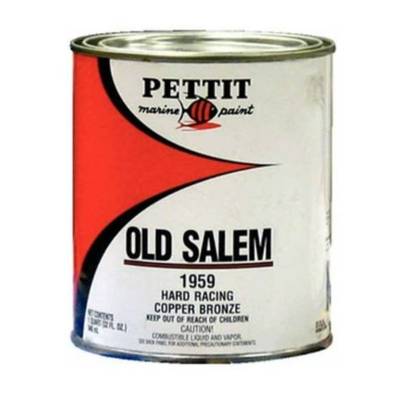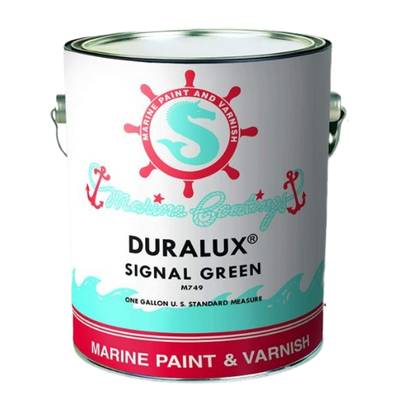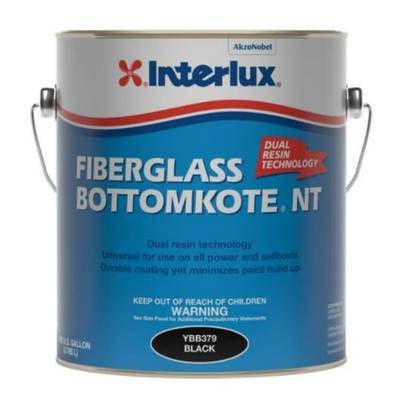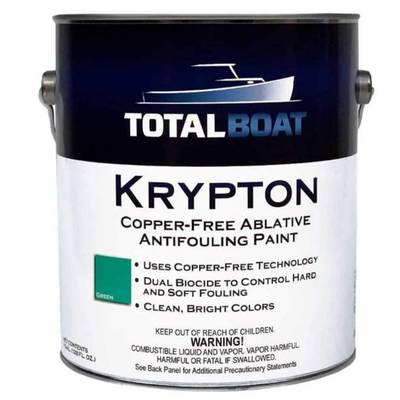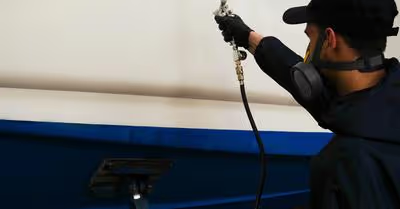
If you’re curious about the best boat bottom paint to make your boat go faster, there are several options that will give you the speed that you’re after.
No matter if you are driving a speedboat or a cabin cruiser, all boat owners want to be able to increase the speed of their vessel when they desire. Most of us know that what sort of paint we put on the bottom of our boat is going to make a difference in our miles per hour, but understanding why and how to find the best paint to achieve optimal speed is something that isn’t so obvious.
The 7 best boat bottom paints for speed are:
- TotalBoat Underdog
- Pettit Paint Copper Bronze Hard Racing Paint
- Duralux M749-1 Marine Paint
- Interlux Fiberglass Bottomkote
- Rust-Oleum Marine Coating
- TotalBoat Krypton Bottom Coat Paint
- Sea Hawk Aluma Boat Paint
Part of what makes boat ownership so fun is the feeling of gliding through waves at speeds that make us feel like we are flying. But to get that desired effect takes more than just a boat with a bigger engine. What type of paint is applied to the bottom of our hull can make a big difference in how easily we attain those speeds and how smoothly our boat will operate while there. Luckily, it’s easy to figure out which paints are going to best bring your boat to top speed and not break your budget in the process.
I love boating and have been an avid boater for years. Though safety is always my main concern, having a boat that glides seamlessly through waters at top speeds is a close second. Learning what paints will best give my boat optimal speed capabilities is something I’ve recently researched, and I’m excited to share my findings with you.
What is the Best Boat Bottom Paint for Speed?
Every boat owner craves those days when the water is as smooth as glass and our boats just cut through it like butter. Or, we can’t wait for those times when the waves send us up in the air and back down again in seconds flat while we continue to chart our course ahead.
In order to get our boats to travel at optimal speeds, a number of factors need to be at play. First, your boat must have a big enough motor to be able to give you the horsepower you desire. Second, you need to have a decent propeller that allows less flex and bend. Third, you should consider the amount of weight on your boat and whether or not you can reduce it. And finally, you need to research carefully what sort of paint you are using on the bottom of your hull and whether or not it’s helping you optimize the speed of your vessel.
Painting the bottom of your hull is a fairly routine part of boat maintenance and care. Not only does painting your boat’s bottom allow you a chance to look for any problems that may be starting, but it’s a great (and very necessary!) way to keep debris off the bottom of your boat.
The process of painting the bottom of a boat is referred to as “antifouling.” Antifouling helps protect your boat’s bottom from all sorts of potential problems, especially in the form of sea life, such as barnacles, algae, moss, and other specimens that live in water and may not be the best things for your boat to have attached to it.
But painting your boat’s bottom sometimes has nothing to do with antifouling, and is instead solely about painting for speed. Depending on what type of paint you apply to the bottom of the hull will make a difference in the speed at which your vessel is able to travel.
Though there are several different types of paint that are specifically made for painting the bottom of your boat, some are going to be better for speed than others.
When you are looking for the best paints for the bottom of your boat’s hull, consider using either a vinyl or Teflon-based type of paint. Both vinyl and Teflon-based paints will provide you with the glass-like finish you are looking for when wanting optimal speed and will serve as an advantage when it comes to fuel efficiency and even safety.
While looking for the best type of paints for the bottom of your boat, also make sure you know which ones you should avoid, if possible. Hard copolymer paints and softer ablative paints are not going to be as ideal for giving you the smooth and finished hull bottom that will allow for the best speeds.
It’s also important to know how much paint you’ll need, since over-purchasing is going to be expensive and under-purchasing is going to result in your boat not being properly protected or as efficient as you’d like.
The general rule of thumb is that you can use about one gallon of paint for boats under 30 feet and two gallons of paint for boats that are 30 feet in length or larger.
Finally, know that you should plan to paint the bottom of your boat about once a year. If your boat is kept on a trailer, or in a garage or warehouse in the off-season, you can probably stretch this out to every two years. But for vessels that stay in the water all year long, painting once a year is a good practice to get into.
Now that we know more about boat bottom painting, let’s find out which paints are going to be best for you and your boat, based on your needs and budget.
1. TotalBoat Underdog
TotalBoat Underdog
One of the best paints on the market for painting the underside of your boat is the antifouling paint, TotalBoat Underdog.
A small business, Total Boat Underdog has been in the paint industry for years, and it shows. Their paint quality is high, their customer service is excellent, and their price is competitive with industry standards.
TotalBoat Underdog antifouling paint comes in three colors to choose from: black, deep blue, and dark red.
One gallon of this paint will allow you to apply two coats of paint to a 25-foot boat. The paint goes on smoothly and there is no need to sand your bottom hull in between applications or after the paint has been applied.
The paint dries relatively quickly, though you should wait at least 15 minutes between applications.
This paint is not intended to use indoors, so make sure the area in which you are painting is well ventilated, or even consider wearing a mask while applying.
Since this is a copper ablative paint, it is going to be best for boats that are made from fiberglass, steel, or iron. You can even use it on boats that have been previously painted with another type of paint, but you may want to be extra careful to apply more than one coat to those vessels if optimal smoothness and speed are your goals.
The TotalBoat Underdog sells for just over $100 per gallon, a reasonable cost for boat antifouling paint. It also has a money-back guarantee if you are not satisfied with the outcome. This is a great option for speed and ultimate boat protection.
2. Pettit Paint Copper Bronzer Hard Racing Paint
Pettit Paint Copper Bronzer Hard Racing Paint
If you are looking for a paint that’s only purpose is to add more speed to your boat, I’ve got just the one for you.
The Pettit Paint Copper Bronzer Hard Racing Paint is an excellent option if the only thing you’re after is more speed from your vessel.
This paint is not intended to act as an antifouling paint, and should not be expected to deter sea life from attaching to your vessel. It’s specifically created to add shine and speed to boats that are kept in freshwater or stored in trailers during the off-season.
One of the coolest things about this paint is its color. When you first apply it, the paint gives off a soft, coppery glow that continues to shine even after months of water contact. The high gloss shine adds to the ease at which this paint will help your boat cut through the water…and it will look amazing while doing it!
Think of using the Pettit Paint Copper Bronzer on sailboats, racing boats, or any speed boat that tends to spend most of its time in freshwater. This paint is going to do best on boats that are made of fiberglass and steel, but should be avoided on hulls that are made of aluminum, since the paint doesn’t seem to adhere to it quite as well as the others.
The Pettit Paint Copper Bronzer retails for around $90 for a quart. It isn’t sold in gallon sizes, but you may be surprised at how far a quart of this paint will actually go.
3. Duralux M749-1 Marine Paint
Duralux M749-1 Marine Paint
The Duralux M749-1 Marine Paint has long been a favorite paint of many boating enthusiasts, and there’s a good reason why. Its high quality and strong reputation are widely known in the industry, and the price is exceptional, especially considering what you get for it.
This paint is an oil-based paint and goes on thick, so it’s suggested you use a thinning agent when applying. You will also want to consider protective eyewear as well as masks, since the fumes can be intense, and even toxic if you don’t have a well-vented area.
But that oily thickness is one of the reasons this paint is so effective for creating more speed from the bottom of your boat. Once applied, the Duralux M749-1 Marine Paint can make a substantial difference in the way your vessel slides through the water.
Avid boat racers are big fans of the Duralux M749-1 Marine Paint. But pleasure boat operators will find it just as beneficial when they are looking for a paint to add some speed as well as protection.
This paint is a great antifouling agent and will protect your boat’s bottom from anything that could attach to and damage it in the long term. It works great against salt water and any chemicals that may be lurking in the waters below your vessel.
One of the other perks of the Duralux M749-1 is the huge array of colors you can choose from. In total, there are ten choices that range from dark red to aquamarine. And, because of the ease at which this paint is applied, most customers have reported that they didn’t need to sand between applications.
The Duralux M749-1 sells for around $65 a gallon and the company stands firmly behind its satisfaction guarantee commitment for all its complete line of paints.
4. Interlux Fiberglass Bottomkote Paint
Interlux Fiberglass Bottomkote Paint
Oftentimes it's hard to find a good bottom hull paint that will give you the benefits you’re looking for, but is not a huge pain to apply. Oil-based paints are great for speed, but can make the prep work, application time, and clean-up a real nightmare.
This is not the case with the Interlux Fiberglass Bottomkote paint. Despite the fact that it is an oil-based ablative paint, the process from start to finish is almost as smooth as the paint itself!
The Interlux Fiberglass Bottomkote paint uses a dual-resin process which means it won’t require any primer or sanding before the first application. Depending on the size of your vessel, you will probably only need one coat as well, which will make a big difference in the overall cost of the paint job, as well as the time required from set up to clean up.
Though this paint is not recommended for aluminum-bottomed boats, it’s great for metal and fiberglass hulls. You can also use it on wood-bottomed boats, since the dual-resin properties work well when adhering to wood surfaces.
There are more than a dozen colors to choose from, and they continue to add more. When applied properly, the paint is great at holding its original color, even in harsher salt water and in marinas where there tends to be gas and chemical build-up.
Anyone who wants to leave their boat in the water during the off-season will be pleased with the results that the Interlux Fiberglass Bottomkote provides. And, during boating season, you will be even more pleased with the improved speed this coating gives to your boat.
The Interlux Fiberglass Bottomkote paint retails for around $110 a gallon, but a little will go a long way, meaning that more than one coat of this paint is probably not necessary. Interlux has a good reputation for standing behind their product and their customer service line is always available to answer any questions you may have while using their product.
5. Rust-Oleum Marine Coating Paint
Rust-Oleum Marine Coating Paint
The Rust-Oleum line of paints has been around for ages, and they are known for producing high-quality products for all sorts of surfaces, inside and out.
So it is no surprise that the Rust-Oleum Marine Coating paint would make my list as one to consider when you want to add protection and speed to your boat’s bottom.
Rust-Oleum Marine Coating is a specially-designed paint for boats that are in need of antifouling protection and want a glossy finish that will allow smooth travel and increased speed. The enamel properties included in the paint mixture will make for an ideal surface coating on any boat bottom that is made from steel surfaces, as well as wood and fiberglass.
Unlike some boat bottom paints, the Rust-Oleum Marine Coating paint doesn’t require any primer before use, meaning that your cost will be less, and your time will be less as well.
Additionally, you can relaunch your boat within 16 hours of applying this paint – a great turnaround time for such detailed work!
This paint is proven to be effective for boats that are kept in saltwater as well as freshwater. Just make sure you give it adequate time to dry, especially if you are relaunching it in a saltwater marina that has a lot of marine activity.
The only potential downside to this choice is that the color choice is limited to black…not ideal for those who want to add a bit more pizazz to the bottom of their hull.
But, if black is a perfectly fine choice for you, then I think you’ll find this paint to be one as well. It retails for around $46 a quart, and is often available in brick-and-mortar stores wherever you can find other Rust-Oleum products.
You can also find it online and it ships quickly to anywhere in the United States.
Rust-Oleum has a one-year, money-back guarantee on all its marine coating paints and customers are always satisfied with how the company handles complaints or concerns about their products.
6. TotalBoat Krypton Bottom Coat Paint
TotalBoat Krypton Bottom Coat Paint
It’s not a shock that two TotalBoat paint products have made my list as being some of the best boat bottom paints for speed.
TotalBoat has an unprecedented reputation in the world of boating products and this one earns a well-deserved spot on any paint job list.
The TotalBoat Krypton Bottom Coat Paint is perfect for anyone who needs a good antifouling protection coat on the bottom of their hull, but also wants maximum performance from their vessel when it comes to speed.
Made of a copolymer formula, the TotalBoat Krypton Bottom Coat is exactly what any avid speed boater is going to find most beneficial when trying to optimize their boat’s capacity for miles per hour. The nature of the copolymer coating means that there is little rigidity to this boat’s surface, which leads to quicker pull through the water and less resistance as well.
The drying time on this paint is impressive, and many customers claim they’ve been able to paint their hull in the morning and launch their boat by mid-afternoon. Prep and clean-up are also a breeze, a real plus when using copolymer paints.
The TotalBoat Krypton Bottom Coat Paint comes in five colors: white, red, dark blue, and sea green. Since only one coat is typically needed, most suggest you only buy one gallon, unless your boat is substantially bigger than 25 feet or so.
It’s easy to find this product online and in many boating supply stores. Since it retails for around $150 a gallon, you may be put off by the higher price tag. But believe me, for the quality of the paint, the ease of use, and the longevity that most customers claim, you won’t be unhappy with the additional few dollars you spend on this paint.
7. Sea Hawk Aluma Boat Paint
As the name implies, the Sea Hawk Aluma Boat Paint is a great option for those boats that are made of aluminum – something that isn’t always available with a number of the other paints on my list.
Many oil-based paints won’t adhere well to aluminum, making it a challenge to find a good antifouling product that will work with aluminum-bottomed boats and give them the necessary protection as well as the increased speed you may be looking for.
But this isn’t the case with the Sea Hawk Aluma Boat Paint.
This paint is specifically designed with aluminum-bottomed boats in mind. The oxide film will not only protect your hull’s bottom from corrosion, sea particles, and salt water, but it will also lend nicely to your craft’s speed, something all boat owners strive for.
The nature of this paint means you will have to do a bit more prep work than you would with some of the other paints on this list. But, since aluminum can be tricky to get paint to adhere to properly, the prep work will be worth it.
A light sanding will be necessary before you apply the Sea Hawk Aluma Boat Paint. Make sure you paint in a well-ventilated area and wear protective face masks, as the paint can be quite toxic.
Once applied, though, you will be happy with the results and can rest assured that not only is your hull protected, but your speed will increase as well.
The Sea Hawk Aluma Boat Paint sells for around $100 a gallon and can be found online and oftentimes at paint supply stores as well.




